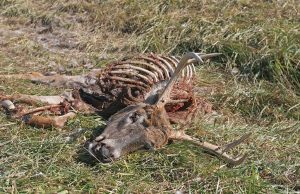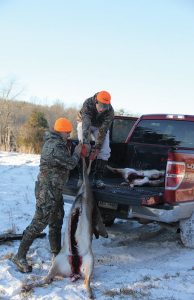If many deer hunters had their way, they’d spend a few hours in their tree watching a parade of deer walk past their stand. Who can blame them? We all love to watch deer, even if we have no intention of pulling the trigger. Whether it’s a group of does feeding in a food plot or a basket-racked eight-pointer slipping under our treestand, more is always better. Or is it?
Truth is, seeing dozens of deer in a single outing may seem like the perfect way to spend an afternoon, but it’s not necessarily good for the habitat. An overpopulation can inflict serious, long-term damage to the landscape, resulting in a downward spiral in deer numbers and health.
“You’ll end up with unhealthy deer, which results in lower body weights, smaller antlers and a decline in fawn survival. That can ultimately lead to an overall decline in deer numbers, so it’s important to make sure you don’t have too many deer than your habitat can support,” says Quality Deer Management Association education director Kip Adams.
It’s not just deer that are affected by an overpopulation of whitetails. They can have an impact on the entire ecosystem. A number of research projects have shown that overbrowsing results in less diverse plant communities, which then impacts a host of game and non-game species, ranging from turkeys to reptiles. A study in Pennsylvania showed a drastic impact on the habitat and a severe decline in species diversity and abundance as a result of too many deer.
“Too Many,” Defined
So how do you know? They may not be obvious, but there are clues that can indicate an overabundance of whitetails. The most visible, says Adams, is a well-defined browse line.
“If you stand in a mature forest and you can see 100, 150 yards because there is virtually no cover at ground level, then you probably have too many deer,” he explains. “Also, if there is a defined browse line on your field edges, that’s a good indication of an overpopulation, too.”
 Whitetails will first eat available foods on or near the ground, including herbaceous growth and tree sprouts, before eating twigs, leaves, buds and vines at or above eye level. Those above-ground foods are often lower in nutrition and digestibility. Deer will eat them only because they have no other choice -- there’s nothing left to eat. The higher the browse line, the more likely you have way too many deer for the habitat. If they have to stand up to reach leaves five or six feet off the ground, then you’ve got way too many deer.
Whitetails will first eat available foods on or near the ground, including herbaceous growth and tree sprouts, before eating twigs, leaves, buds and vines at or above eye level. Those above-ground foods are often lower in nutrition and digestibility. Deer will eat them only because they have no other choice -- there’s nothing left to eat. The higher the browse line, the more likely you have way too many deer for the habitat. If they have to stand up to reach leaves five or six feet off the ground, then you’ve got way too many deer.
Adams also says overbrowsed food plots are also a good indication of too many deer.
“If your food plots get eaten down to nothing, that’s either an indication of too many deer or poor habitat or a combination of both,” says Adams. “Of course, a small food plot may not last very long, no matter how many deer you have, but if the habitat is good, then your deer herd won’t concentrate all their efforts on your food plots.”
Too Few? That’s a Problem, Too
Although a lack of deer is not necessarily detrimental to the habitat, it can have a lasting impact just the same. Whitetails have always been an integral part of the landscape. They serve as a food source for predators and even scavengers, and they can also help distribute the seeds of beneficial plants.
More important, at least from a hunter’s perspective, a lack of deer can result in poor hunting and even a decline in hunting participation on a larger scale. Hunters are a vital part of the economy and an even bigger part of the conservation equation.
“There’s no question it’s important to have an abundant deer population for hunters to want to continue hunting,” says Adams.
Count Your Deer
The exact number of deer on your land is somewhat less important than their impact on the habitat. However, in order to get a handle on population trends, it’s a good idea to conduct camera surveys. Through research, biologists have determined that there’s no better way to conduct accurate deer counts than by using trail cameras placed over corn to get a good idea of your population.
The key, says Adams, is to gather at least three years of populations, though it’s better to get as many added years as you can.
“By having a couple of years of deer counts, you can determine if their numbers are going up or down and you can make adjustments to your annual harvest based on those trends and what is best for your habitat,” says Adams.
A single-year survey can at least give you a starting point. Be careful, though. Just because you aren’t seeing many deer from your stand doesn’t mean they aren’t there. Hunting pressure can turn many deer into nocturnal creatures, but a remote, motion-sensor camera can show you things you may not be seeing.
A study conducted by researchers at Auburn University found that a camera every 100 acres and left in place for ten days was sufficient for capturing all the deer utilizing the property. They used corn to draw deer to a specific location.
The hard part is assessing your doe population. They all look the same. However, there’s an easy solution through extrapolation. Say, for example, you get 40 images of antlered bucks and ten of those captures are individual bucks as determined by their unique antler characteristics. That translates to four photos per buck. You can determine your doe population by using the same 4 captures per one buck ratio. If you have photos of 100 does, for example, then you can assume you have 25 does.
Population Solutions
Whether or not 35 total deer is an issue or not is something you’ll have to decide through habitat assessment. If you do have too many, that can be solved through additional harvest of antlerless deer. Although many hunters prefer to shoot any deer with antlers, that won’t solve long-term population issues.
“Does are the ones that produce future deer, so if your goal is to reduce the population, shoot more does,” says Adams.
Of course, if your habitat can support many more deer, the best solution is to lay off the does for a few years. It’s not a bad idea to shoot fewer bucks, too. Excessive buck harvest can result in skewed buck-doe ratios, which can further degrade the quality of your deer herd.
Buck-Doe Ratios
 Deer populations, whether high, low or just right, aren’t the only thing you need to consider. Buck-to-doe ratios also factor into the health of your deer herd. Those numbers have little impact on the habitat, of course. A buck eats the same amount and type of food a doe eats.
Deer populations, whether high, low or just right, aren’t the only thing you need to consider. Buck-to-doe ratios also factor into the health of your deer herd. Those numbers have little impact on the habitat, of course. A buck eats the same amount and type of food a doe eats.
An abnormally high doe-to-buck ratio, however, can result in later breeding, which then results in later fawn births. Late-born fawns tend to weigh less and have poorer health going into the winter and lower survival rates.
The problem, says Virginia Department of Game and Inland Fisheries deer program leader Matt Knox, is that many hunters confuse antlerless deer with antlered deer. He points to a frequent conversation he has with his state’s hunters.
“They tell me they see 20 anterless deer in a field and only a couple of bucks, so the buck-to-doe ratio must be way out of whack. What they are more likely seeing are a bunch of fawns in addition to does and antlered bucks,” he explains. “Statistically, half those fawns are bucks, so the buck-to-doe ratio probably isn’t as bad as they assume.”
Knox says a doe will usually bear one fawn so for every adult doe in that group, there is one fawn. Of the 16 antlerless deer, eight will be fawns and four of those fawns will be bucks.
“Of course, not all fawns survive, but it’s fair to assume that mortality rates are generally equal for male fawns and female fawns, so the number of each in the population will be equal. Assuming zero fawn mortality, that gives you a total of eight bucks and 12 does for a ratio of 1 to 1.5. That’s a pretty good ratio,” adds Knox.
Adams agrees and says that in most situations sex ratios are typically not an issue. What matters most in that case is the age ratio. An overabundance of antlerless deer, including young-of-the-year, are more likely to indicate a poor age structure.
In other words, if you want to see more antlered deer, don’t shoot as many antlered deer as you have in the past.






